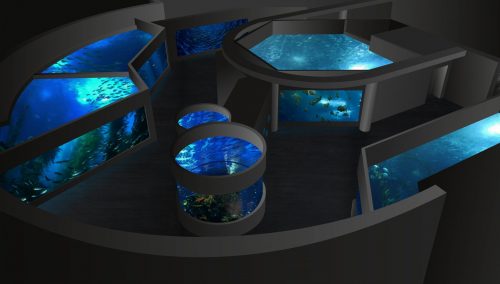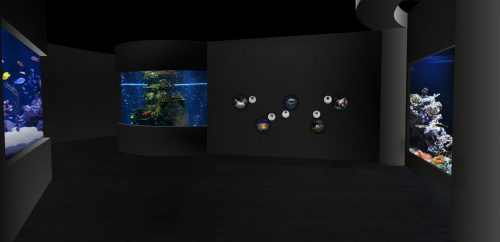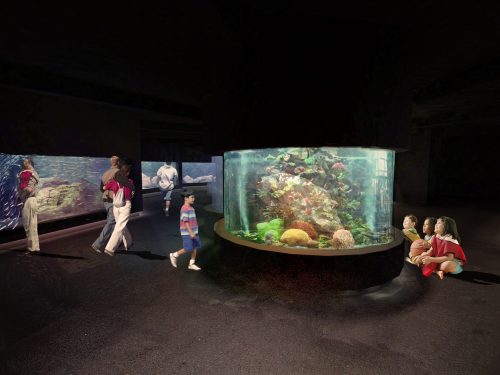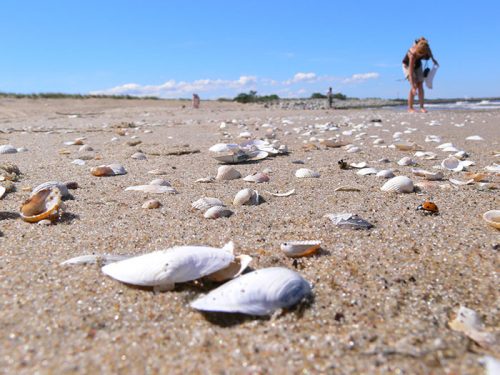 Topic proposed in the period from April to September. The first part of the class is a 30-minute multimedia presentation “What lives in the Baltic Sea – a walk on the beach”, during which children learn what animals they may encounter on the beach during an ordinary walk, what lives in the coastal waters of the Baltic. The second part, also 30 minutes long, is an exit to the waterfront, near the Gdynia Aquarium with nets – landing nets. In this part of the classes, children under the care of a lecturer fish coastal organisms, which then, after returning to the Aquarium, watch in the laboratory. Work in the laboratory lasts another 30 minutes. Children using magnifying glasses and binoculars watch caught specimens and previously prepared biological material, recognize Baltic shrimps and mussels. During classes, children complete prepared work cards. The conditions for conducting field classes are appropriate weather. In the event of exceptionally unfavorable weather conditions, we reserve the right to cancel the field part of the classes and exchange laboratory classes.
Topic proposed in the period from April to September. The first part of the class is a 30-minute multimedia presentation “What lives in the Baltic Sea – a walk on the beach”, during which children learn what animals they may encounter on the beach during an ordinary walk, what lives in the coastal waters of the Baltic. The second part, also 30 minutes long, is an exit to the waterfront, near the Gdynia Aquarium with nets – landing nets. In this part of the classes, children under the care of a lecturer fish coastal organisms, which then, after returning to the Aquarium, watch in the laboratory. Work in the laboratory lasts another 30 minutes. Children using magnifying glasses and binoculars watch caught specimens and previously prepared biological material, recognize Baltic shrimps and mussels. During classes, children complete prepared work cards. The conditions for conducting field classes are appropriate weather. In the event of exceptionally unfavorable weather conditions, we reserve the right to cancel the field part of the classes and exchange laboratory classes.
Akwarium Gdyńskie
-
Meeting with the Baltic Sea
-
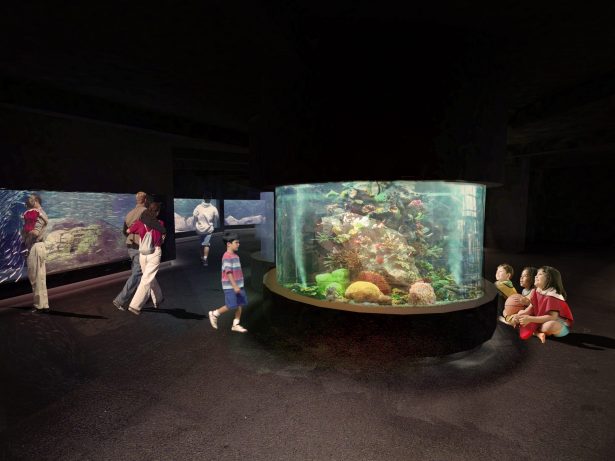
Agreement for the expansion of the Gdynia Aquarium exhibition signed!
On Monday, July 15, 2019, at the Marshal Office of the Pomorskie region, an agreement was signed to co-finance the project “Expansion of the Educational Path of the NMFRI Gdynia Aquarium” under 11.4 RPO WP 2014-2020.
What does that mean for the Gdynia Aquarium?
The enlargement of the exhibition space will be realized in the basement of the building. On the previously unused area of 900m2, there will be 13 reservoirs presenting water animals, which until now could not be exposed due to space limitations.
The volume of water in these thirteen aquariums will be larger than the volume of all our present tanks! The smallest aquarium will have over 2 000 and the largest 127 000 liters. The volume of water in the Gdynia Aquarium will rise by a total of 450 000 liters.
In the planned space, there will be aquariums in which, among others, cartilaginous fish will live, namely sharks and rays. It will be presented how some marine conditions, like salinity, waving, or different types of substrates, influence animals that inhabit different water bodies.
In addition to expanding the exhibition, we plan to organize engaging activities for kids and entire families. This new space will help us to explain the relationships that connect the maritime world with the world of people. It will also be easier for us to present ecological problems that nature must presently face.
However, arranging the exhibition space in a place up to now unprepared for tourists requires a number of construction works at the beginning. This includes strengthening the existing building structure, lowering the foundations and the basement floor, making a staircase, building a new elevator and all other necessary installations.
The implementation of this project will be a challenge for us. However, the planned works should not affect the operation of the NMFRI Gdynia Aquarium.
The total cost of the project is 16 521 573,79 zł.

-
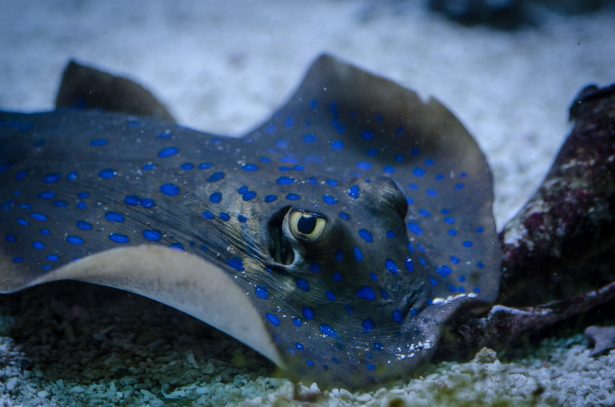
Bluespotted ribbontail ray
Order: Myliobatiformes
family: Whiptail stingrayTaeniura lymma
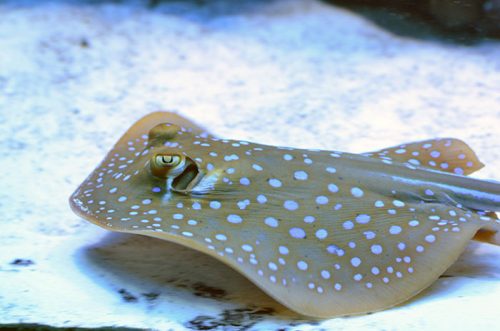 The Bluespotted ribbontail ray, a representative of cartilaginous fish, is common in the Indo-Pacific from southern Africa to the Solomon Islands, including the Red Sea. This is the most common stingray among coral reefs. Interestingly, adults and adolescents live in different habitats. Adult stingrays occur in deeper reefs (up to 20 meters deep), while young prefer warm, shallow waters with a bottom covered with seagrass, mangroves or covered with rocks, where they find shelter from predators. The Bluespotted ribbontail ray grows up to 70 cm in length with its tail being half of this length. The maximum width of her body is 30 cm. Its main food are annelids, small molluscs, crustaceans and cephalopods, which it finds by combing the sandy bottom. In this way, it plays an important ecological role as a bioturbator by modeling bottom morphology, and also determines the density patterns and distribution of benthic infauna (organisms living in bottom sediments). It hunts mainly at night, and spends the day still.
The Bluespotted ribbontail ray, a representative of cartilaginous fish, is common in the Indo-Pacific from southern Africa to the Solomon Islands, including the Red Sea. This is the most common stingray among coral reefs. Interestingly, adults and adolescents live in different habitats. Adult stingrays occur in deeper reefs (up to 20 meters deep), while young prefer warm, shallow waters with a bottom covered with seagrass, mangroves or covered with rocks, where they find shelter from predators. The Bluespotted ribbontail ray grows up to 70 cm in length with its tail being half of this length. The maximum width of her body is 30 cm. Its main food are annelids, small molluscs, crustaceans and cephalopods, which it finds by combing the sandy bottom. In this way, it plays an important ecological role as a bioturbator by modeling bottom morphology, and also determines the density patterns and distribution of benthic infauna (organisms living in bottom sediments). It hunts mainly at night, and spends the day still.
T. lymma has a characteristic blue dots on the back, and the tail is distinguished by blue stripes on both sides. At the end of the tail are two sharp venom spines that are used for defense. They are remnants of skin teeth that covered the body of stingrays. Lost spikes grow back and the wounds inflicted by them are very painful. It is a ovoviviparous species. During courtship the male bites the female. Pregnancy can last from 4 to 11 months depending on many external factors. Such a long pregnancy makes them more susceptible to the collapse of the population. Fortunately, these rays are able to breed in captivity. -
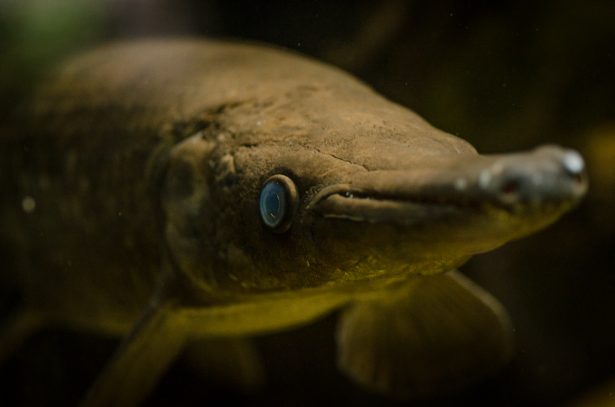
Aligator gar
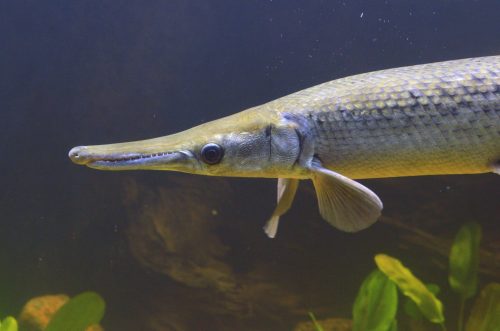 Atractosteus spatula
Atractosteus spatulaThe Aligator gar looks like something between a pike and a crocodile: a lengthened trunk with three fins in the tail part refers to a pike, and long, toothed jaws are associated with a crocodile. The Aligator gars do not take care of their offspring. They are the largest freshwater fish in North America and may exceed the length of 3 m and the weight of 100 kg. They hunt for large prey, not only for other fish, but also for lizards, snakes and turtles.
It is one of the most primitive and the largest freshwater fish species in the world. Fossils from the Cretaceous period (145-66 million years ago) have been found in America, Europe and Asia. Currently, their natural environment are lakes, rivers and reservoirs in central and northern America, however, their number is constantly decreasing due to overfishing and dams, which prevent reproduction. They reach huge sizes, grow up to 200 cm on average and the largest specimen caught was 305 cm in length and weighed 166 kg. They can live up to 50 years. From time to time, the fish is observed to swim under the surface of water to get extra air, which makes it easier to survive in a low oxygen environment. It is possible thanks to the vascularized bladder connected to the pharynx. Female may deposit 138,000 eggs at a time. The eggs are bright orange and unfit for consumption, as they are poisonous. The Alligator gar has two rows of teeth and the internal row is longer. This feature allows to catch and effectively hold the victim in the mortal grip of strong jaws.
-
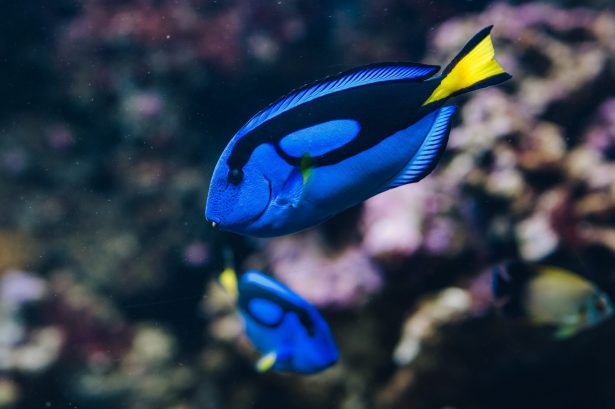
Blue surgeonfish
order: Perciformes
family: Acanthuridae
Paracanthurus hepatus
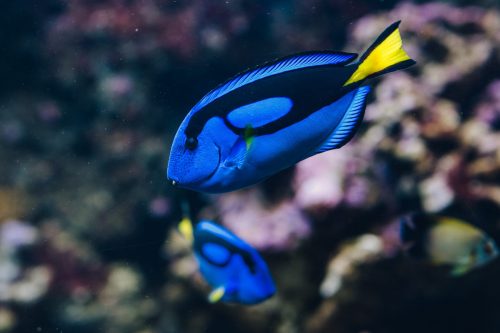
The only representative of the genus Paracanthurus.
The Blue surgeonfish is found in the coastal waters of the Indo-Pacific Ocean, from the coasts of East Africa to Oceania, excluding the Red Sea. It has a wide extent of occurrence, but is not common. We can meet it, among others, on the coral reefs of the Philippines, Indonesia, Japan, Australia, New Caledonia, Samoa, as well as Sri Lanka. It is associated with coral reefs, it lives mainly near their outer parts, where sea currents are stronger. The extent of occurance is related to its love of swimming. It inhabits coastal waters with a bottom covered with vegetation. It can be observed at depths from 1 to 40 meters. Its maximum length is 31 cm, but they usually grow up to 20 cm. It can live up to 30 years in the wild, and 8 to 20 years in captivity. Its food is comprised mainly of zooplankton and algae. Juveniles feed exclusively on plankton. It is a very important inhabitant of the reefs, because he cleanses corals of algae growing on them, thus keeping them in good condition. Most often, this species lives in pairs or form small groups of 8 to 14 animals.
Its characteristic feature is its coloration, blue body with black back and yellow fins. The attractive colors makes it a popular aquarium fish. Until recently, all individuals that we could admire in aquariums were caught directly from their natural environment. Currently, this species is successfully propagated in laboratory conditions, but not on a global scale. The larvae differ significantly in color from adults. Their body is almost transparent and silvery. It gradually turns blue, yellow pigmentation appears at the very end of development. At night its blue color pales, presumably avoiding the attack of nocturnal predators. Another characteristic feature of the Blue surgeonfish is the presence of sharp, poisonous spikes located on the tail, one on each side, which are used for defense. It is not of great commercial importance, but it can account for a significant proportion of inshore fisheries.
Its meat has an unpleasant smell and is poisonous. After ingesting it, the symptoms of food poisoning may occur.
This surgeonfish does not produce a toxin (ciguatoxin) by itself. It is accumulated in its body along with the consumed algae that produce toxin.
Why is it blue?
The fish do not have blue pigment in their skin. The blue color that we can see is nothing but a light phenomenon. Isidophores, i.e. pigment cells that reflect light, are responsible for this phenomenon. In the light they create iridescent colors, but by proper orientation of the schematochromes (prism-like structures, refracting and dispersing visible light to the surroundings,) and using biochromes (biological pigments) as a filter, they create a blue color.
-
Mapa
<iframe src=”https://www.google.com/maps/embed?pb=!1m18!1m12!1m3!1d2315.860001540381!2d18.55504176623364!3d54.51833034397911!2m3!1f0!2f0!3f0!3m2!1i1024!2i768!4f13.1!3m3!1m2!1s0x46fda73895878e65%3A0xb9e8a3098b7fe123!2sAkwarium+Gdy%C5%84skie+MIR!5e0!3m2!1spl!2spl!4v1561980981309!5m2!1spl!2spl” width=”1920″ height=”600″ frameborder=”0″ style=”border:0″ allowfullscreen></iframe>
